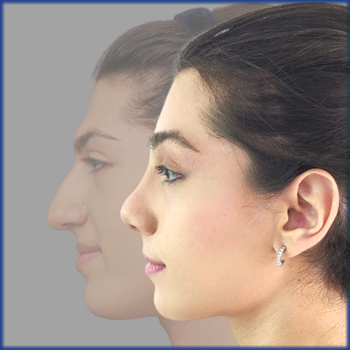Changes in orofacial tissues in people with cleft lip
Normally, the muscles around the mouth form a complete ring (Figure 3) and this helps complete closing of the mouth when these muscles are contracted. Further contraction results in puckered lips. Clefts disarrange this muscular ring, thereby preventing complete closing of the mouth. In this case, the edges of the cleft move further away. This gives the person an unpleasant look (Figure 4).
How cleft lip affects the shape of the nose
Complete clefts extended to nostrils connect the end of the orofacial muscles at either side of the cleft to edges of the nostrils. In this case, any contraction in muscles around the mouth will extend nostrils at either side, which makes the nostril at the affected side look bigger and wider (Figure 5). A complete cleft is usually the result of incomplete development of the bone covered by the cleft, and as seen in the figure below, the nostril at the affected side looks closer to the face than the other nostril.
Related complications
A very common condition related to clefts is cleft palate (this topic is covered in another section of the website). Incompletely developed palate results in an abnormal connection between the nostrils and the mouth (Figure 6).
Fortunately, babies with healthy palate, and only cleft lip, do not usually suffer from problems during breastfeeding. In most cases, teeth grow abnormally and require special treatment.
Babies with cleft lip often have conditions in other parts of their bodies (form of the head, eyes, heart, etc.). Therefore, a doctor who first examines a baby should take note of this and fully examine the baby.
Indirect complications
Psychological effects of cleft lip first appear in parents. The effects vary depending on socio-cultural status of the family. Parents who get disappointed by this situation may make the condition worse by ignoring the situation and not seeking proper treatment.
Fortunately, these children are totally normal in terms of intelligence and talent and have capabilities similar to their peers. I have met students who came to my office to correct the last remaining traces of cleft lip. I have also seen people who had done nothing about this until they reached the age of 23. If you look closely, you can see that the beautiful features of other parts of their faces cover this flaw. Fortunately, advancements in science and technology have made it possible to help these individual regain their beauty and live a normal life.
Proper treatment age
Although cleft lip can be treated from the very early days, but it is usually recommended that treatment should start when the baby is three months old. At this age, the suckling infant has reached a more proper stage of development, giving him or her more appropriate condition for treatment. Treatments may start with initial corrections on the nose. This will help getting better results in next surgical procedure.
Required post-surgical corrections
Once the cleft lip is corrected, the traces become more apparent as the child grows older. In addition, the unusual shape of the nose will become more prominent. Therefore, further corrections on the nose and the surgery spot are often required once the child reaches puberty. These are often done in several stages and people who undergo all these stages usually get better results (Figures 7 and 8).


